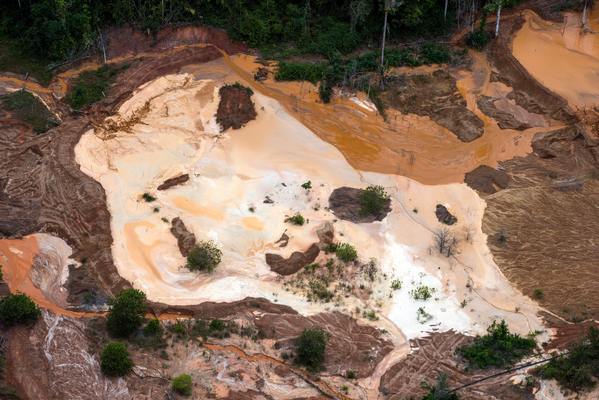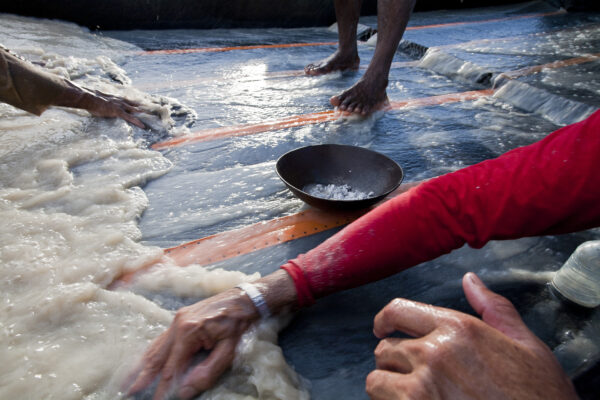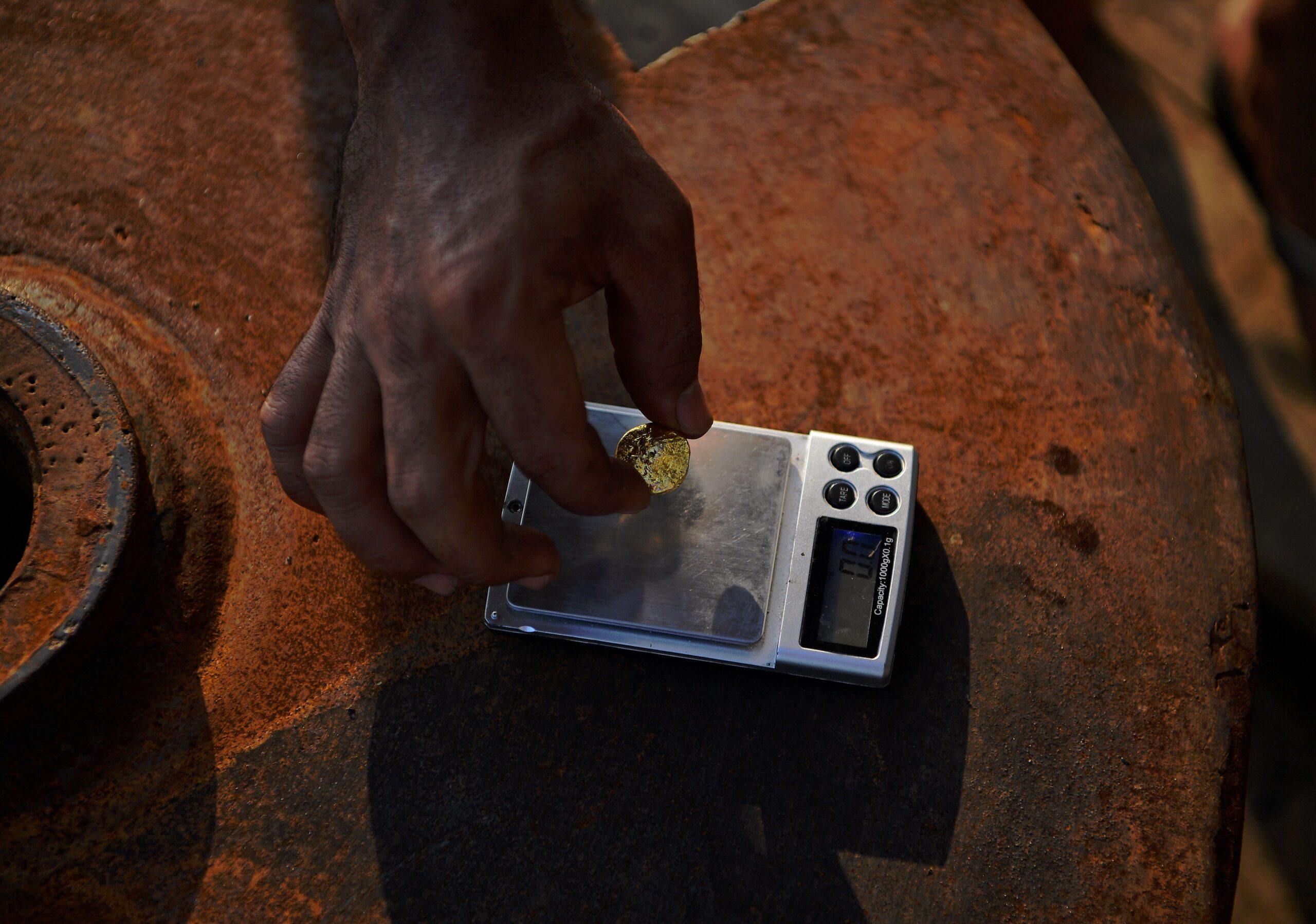Indigenous ‘blood gold’ almost certainly exported to UK, say Brazilian researchers
‘It is completely impossible for the United Kingdom to know if the gold it imports from Brazil is legal’

Wildcat gold mining in the Amazon is soaring, and the supply chain is so opaque that illegal Amazon gold is almost certainly being imported by the UK, according to a study released this week.
Almost 30% of the gold produced in Brazil from 2019-20 was likely to have been illegally mined, coming overwhelmingly from the Amazon region, the joint study by public prosecutors and the Federal University of Minas Gerais said.
A lawsuit based on the research, filed on Monday, called for three major gold companies to pay hefty fines and have their activities suspended. They are alleged to have traded in a combined 4.3 tonnes of illegal gold over 2019-20 from lawless southwest Pará state, an area that has seen a surge in illegal mining linked to deforestation, mercury poisoning and violent conflicts with Indigenous people.
“In the UK…regulators have decided to put the interests of anonymous investors ahead of human rights and environmental issues”
Separately, a Mapbiomas analysis released on Monday showed that mining in Indigenous lands had soared sixfold in the past decade, and quadrupled in conservation areas.
Mining in nature reserves and Indigenous land is prohibited. Wildcat miners often use mercury to amalgamate the gold, which poisons rivers and has been shown to harm Indigenous people’s health.
The UK is the third-largest importer of Brazilian gold. The study’s author told Unearthed that a lack of transparency surrounding the gold supply chain means it is impossible to say with confidence that no illegal gold is entering British markets.
Of the 174 tonnes of gold traded in Brazil from 2019-2020, at least 49 tonnes were illegal, of which 90 percent came from the Amazon, the study said, causing an estimated R$31.4 billion (£4.43 billion) in socio-environmental damage.
The illegal gold was valued at around R$1.2 billion (£170 million) and linked to some 21,000 hectares of Amazon deforestation.
Gildázio, a mining consultant who asked to only be identified by his first name because of the sensitivity of the subject, told Unearthed he found the figures unsurprising. He described a street lined with small gold buyers and jewellery shops called Rua do Ouro (Gold Street) in Boa Vista, Roraima state.

“The miners bring the gold they mine in Indigenous areas… and sell it there in Boa Vista,” he said. “I was there in one of the gold purchasers. Just to give you an idea, every day 3-6kg of gold was entering this one little shop, every day.”
Boa Vista is close to Yanomami Indigenous land, where some 20,000 wildcat gold miners are working illegally.
“The miners bring the gold they mine in Indigenous areas and sell it there in Boa Vista…Just to give you an idea, every day 3-6kg of gold was entering this one little shop”
The researchers cross-referenced satellite monitoring data with 17,500 transactions registered at the Brazil’s Mining Agency (ANM) in 2019 and 2020.
Raoni Rajão, who led the study, said that the figures were conservative, as the researchers only included gold that had entered the legal taxation system. Tonnes more almost certainly leave the country without trace, he said. Gildázio confirmed that he had witnessed a flow of gold across the borders of Venezuela, Guyana, Suriname and other neighbouring countries.
Trade data analysed by Global Witness bears this out: in 2017, Peru and Suriname showed wide gulfs in the quantities of gold they reportedly produced and the quantities they exported – 342 tonnes and 154 tonnes respectively, indicating the countries exported many tonnes of gold mined elsewhere.
The researchers found a pattern of transactions registered to areas that had licences for small-scale mining, known as a PLGs, but which showed no evidence of mining on satellite imagery. The gold was likely to have come from elsewhere – such as Indigenous lands or Conservation Units, where mining is prohibited – and been laundered through the sham licence.
Gildázio said this happens widely throughout Amazon mining areas, and is known as “warming” the gold.
“I knew a company in Roraima which had a PLG and it didn’t produce 1 single gram of gold, but it sold gold,” he explained. “The miners brought the gold in, registered it on the document of the company’s PLG, he issued the receipt, and that’s what we call a warm up. There are many people who started to turn the practice of getting PLGs into a business… they warm the gold and earn commission on it.”

A second mining consultant told Unearthed that individual miners, who often come from low income areas and have few other options for work, were sometimes forced to mine illegally because it took a long time to get a legal licence. “A big company, which has capital … can stay there waiting months, years, to get its title. But a person, a miner, a man, he has to buy beans and rice and he has to work that same day. So he can’t wait.”
Luís Camões Boaventura, a public prosecutor who led a large-scale investigation into illegal gold from 2016-2019, attributed the ease of gold laundering in the Amazon to a flawed and outdated system.
“The documentation is highly archaic,” he told Unearthed. “Anyone with a piece of paper and a pen can give this gold a lawful appearance.”
He added: “The way that the gold economic chain in Brazil is designed today, it is completely impossible for the United Kingdom or any other importer to know if the gold it acquires has a legal origin.”
Most of Brazil’s gold is exported – in 2020, 81% of total production – and the UK is one of the biggest buyers, importing 29 tonnes in 2019 and 2020. Only Canada and Switzerland imported more – 68 tonnes and 42 tonnes respectively.
Once laundered into the legitimate supply chain, it is impossible to trace. The report noted that it had not been possible to trace illegal gold into the export market. But it added: “Given the concentration of actors and the prevalence of irregularities, it is likely that a substantial amount of illegal or potentially illegal gold will supply the North American and European markets.”
Rajão told Unearthed it is impossible to rule out that gold from Indigenous territories was circulating in the UK.
“Given the volumes acquired by the UK and given the amount of illegal gold very likely coming from Indigenous lands, it is very hard to think otherwise,” he said.
Investigations in Brazil have yielded the names of multiple gold exporters that allegedly trade in illegal gold. But finding out who in the UK is buying from them is difficult.
“In the UK – and it’s the same in Switzerland – regulators have decided to put the interests of anonymous investors ahead of human rights and environmental issues, it is as simple as that,” Rajão said.
Rajão compared this to the US, which in 2010 passed a law requiring publicly listed companies to file reports on conflict minerals in their supply chains with regulators.
“This really increased transparency… We have a great chance here, because the UK is debating its due diligence legislation, looking especially [at]deforestation and agricultural products,” he said. “But gold not only generates deforestation, but all sorts of mercury contamination and crime, so it must be included.
HMRC told Unearthed that it acknowledged that extracting conflict minerals such as gold “can be linked to a range of deplorable practices from human rights abuses to illicit financing of conflict” and encouraged importers to follow the Organisation for Economic Cooperation and Development’s due diligence guidance on conflict minerals.
The OECD said that it was up to individual companies to decide whether they were sourcing from a high-risk area. It noted that “when we say ‘high-risk’ we generally refer to risks covered in the Guidance, namely human rights abuse, conflict finance, and financial crime.” Environmental degradation is not covered in the guidance.
The research also showed that at a higher level, illegal trading appeared to be concentrated among a few actors. Under Brazilian law, gold extracted from small-scale mines – “garimpos” – ought to be sold as a financial asset to an officially recognised trading company, which has legal permission from the central bank to export gold.
The researchers concluded that only three such traders were responsible for the purchase of 71% of the illegal gold.
Based on the research, Brazil’s public prosecutor filed a lawsuit on Monday calling for these three gold exporters to be suspended for trading in more than 4.3 tonnes of illegal gold from Pará state between 2019 and 2020, and for the companies to pay R$ 10.6 billion in social and environmental damages.
The MPF alleges that the gold originated from illegal mines in Itaituba, Jacareacanga and Novo Progresso.
Munduruku Indigenous Land overlaps with Jacareacanga municipality, and has seen significant incursions by gold miners. ISA, an environmental and social organisation representing Munduruku Indigenous Land, calculated that the area degraded by illegal gold mining almost quintupled from January 2019 to May 2021, destroying an additional 2,265 ha. In May, during a Federal Police operation to remove illegal gold miners from Munduruku land, armed invaders attacked a Munduruku village, firing shots and setting buildings on fire. In June, illegal miners attacked a bus carrying Indigenous leaders.
A 2019 Fiocruz study of Munduruku villagers close to mining areas found high levels of mercury contamination. In the villages by the affected rivers, 9 out of 10 participants showed high levels of contamination, and 16% of children showed neurodevelopment issues.

